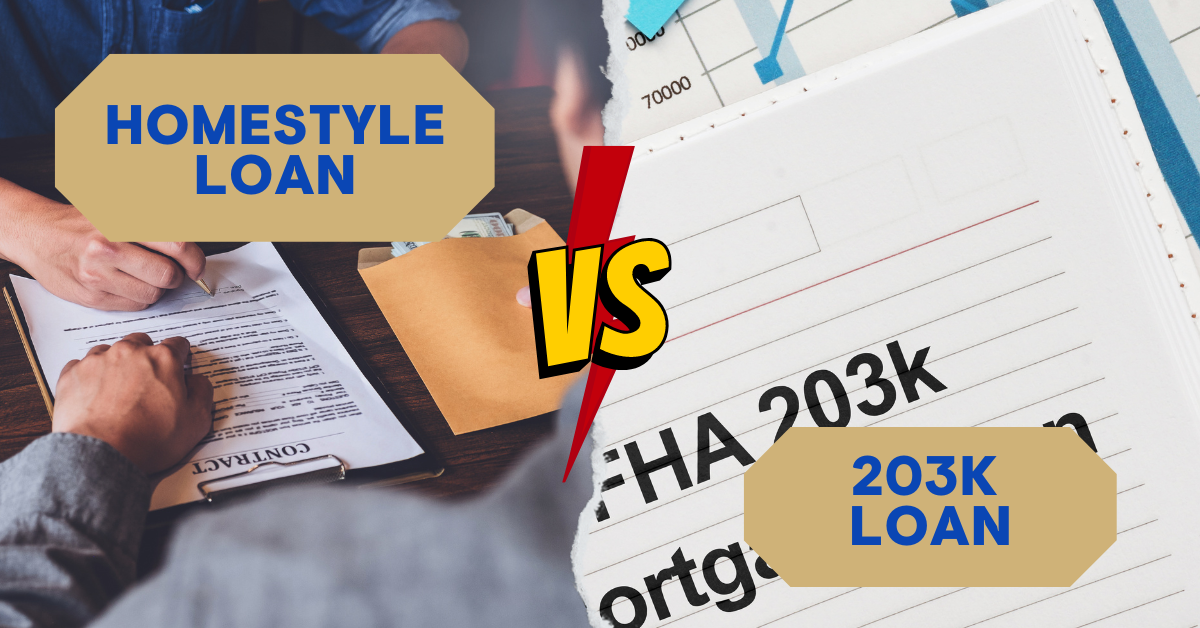203(k) vs HomeStyle Renovation Loans: Which Is Best for You?
.
It’s always easier to find projects to do around your house than it is to find money to pay for them. If you don’t have a ton of extra cash socked away for covering renovation projects, there are special loans that can be used just for these types of projects. They are 203(k) renovation loans and the HomeStyle renovation loans. But, homestyle loan vs 203k: Which is best for you?
Loan overviews
Understanding 203(k) Renovation Loans
The Federal Housing Administration (FHA) offers a home renovation loan officially called 203(k) Rehab Mortgage Insurance. This government loan enables homebuyers and homeowners to finance both the purchase (or refinancing) of a house and the cost of its rehabilitation through a single mortgage or to finance the rehabilitation of their existing home.
There is a full version of this loan and a limited version. The limited 203(k) loan has a renovation limit of $35,000. The full version does not have a set upper limit but does have a minimum of $5,000 in renovation costs.
The full 203(k) allows any type of renovation except the inclusion of luxury items. The limited 203(k) allows any type of renovation except the installation of luxury structural work, additions, and landscaping.
Exploring HomeStyle Renovation Loans
Fannie Mae offers two types of HomeStyle® Renovation Loan types for homebuyers.
HomeStyle® can be used to purchase or refinance a home. It requires a down payment of 5% if the home will be owner-occupied or 10% if it’s a second home. This type of loan permits all renovation work, including the installation of luxury items.
HomeStyle® 3% Down features a lower down payment than its peer at 3%, but it can only be used for renovations on a home purchase, not refinancing. This type of loan permits all renovation work, including luxury items, but the renovations must add value to the property.
Both HomeStyle loans have less stringent standards for borrowers than private lenders like banks. That means things like your credit score don’t need to be as strong for this type of government loan.
Making the Right Choice: 203(k) vs HomeStyle Loans
Before diving into the nitty-gritty of these loans, take a moment to evaluate your personal finances, your credit score, and how long you plan on living in the home you’d like to renovate. All of these factors play a part in determining which loan option is best for you.
You should also have a very concrete idea of what kind of renovations you’ll be making. Both loans require a list of specific renovations you want to do. You’ll also need to find and hire a contractor or other professional to finalize your renovation plans—including a budget. When you have these plans finalized, they’ll be submitted to your chosen lender.
Let’s dive in homestyle loan vs 203k and see the pros and cons to each one:
Pros and Cons of 203(k) Loans
In general, the 203(k) loan is stricter about the type, value, and condition of the home you’re looking to purchase and renovate than a conventional loan. On the other hand, the 203(k) loan’s borrower requirements are more flexible, so it’s possible to have a lower-than-average credit score or a high-than-average debt-to-income (DTI) ratio and still be approved for this type of loan.
Another benefit is a lower down payment. You can put as little as 3.5% down on the total of the purchase and the improvements added up together. You also can wait to conduct required appraisal repairs until after closing, and all you need to do is add them to the bid that you have from the contractor that you chose.
The 203(k) also has homebuyer protections built into the appraisal process. For example, let’s say you plan to purchase a home for $80,000 and make $20,000 in renovations. An appraiser will put a value on the house in its current state and its state after renovations are done, known as an “as completed appraisal.” In the case of a conventional loan, it’s expected the appraisal of the home’s value comes to at least $100,000 in order to proceed with the loan process. If the appraisal amount comes back for less than $100,000 in this case, you’ll need to make up the difference with your own funds. That’s not the case with 203(k) loans. As a borrower, you are protected if the appraisal comes in as less. You can still put 3.5% down and receive the full loan amount.
One potential downside to using a 203(k) loan is that it can only be used if you’re going to own and occupy the house. However, it does allow you to purchase and renovate more than just single-family homes. You can buy a two-unit, three-unit, or four-unit home, and you can still put just 3.5% down (but remember, you need to be living in it).
In general, another downside for FHA loans is that the mortgage insurance never drops off. So if you’re leary of having a big monthly payment, this loan might not be the one for you.
It’s also important to understand you can’t use family connections as part of the 203(k) process. That means you can’t buy the house from relatives or use a relative for services. That includes real estate agents, contractors, and even insurance agents.
Lastly, there are extra costs associated with the 203(k) loan. As part of the process, you’ll need to use a 203(k) consultant, also known as a Housing and Urban Development (HUD) consultant, which can add anywhere from $400 to $1,000 in extra costs to your loan.
Pros and Cons of HomeStyle Loans
HomeStyle loans in general have slightly stricter borrower requirements than 203(k) loans, but allow for larger loan amounts, which will vary based on the state and country where you are purchasing. And unlike the 203(k), you can use HomeStyle loans to renovate a second home and even an investment property.
There also are low-down payment options. You can actually put as little as 3% down if you fit into the category that allows it. As for monthly mortgage payments, they tend to be smaller in the long run as the mortgage insurance will fall off the loan once you’ve reached 20% equity in your home—you’ve paid off a portion of your loan that amounts to 20% of the home’s total value—or if you’ve reached 12 years of payments. However, if you have a credit score of less than 700, the monthly payment and the monthly mortgage insurance is going to be higher for as long as it’s on your loan.
Unlike 203(k) loans, you don’t need to pay a HUD consultant and can use third-party review companies to complete the same functions and save you money.
Remember the completed value appraisal example mentioned in the 203(k) pros and cons? When it comes to HomeStyle loans, your appraisal needs to come in dollar for dollar in order to secure the full loan amount. In the example using a total home value of $100,0000 after renovations, an appraisal coming in at $95,000 means you’re on the hook for coming up with the additional $5,000.
What kind of renovations can I do under both the 203(k) and the HomeStyle loans?
There are restrictions on what kind of renovations you can do using each loan. In the case of the 203(k) loan types, the list is pretty extensive. For example, you can install a new roof, windows, and siding. You can put appliances in the home, you can install new flooring, you can do a kitchen remodel, and you can add a deck and a patio. However, you can’t use the loan to install luxury items.
The HomeStyle allows all the renovations that the 203(k) does, but it also allows you to put in luxury items, such as a pool or a basketball court.
How can my lender help me figure out homestyle loan vs 203k is best?
The key to finding out if a 203(k) or a HomeStyle loan is right for you is to first find a lender that offers both of them so that you can compare them from a high-level view.
The 203(k) loan often is best for homebuyers who are more limited with the amount of funds that they have available, have credit scores that have either fallen below the 700 mark or haven’t been built to that level yet, or have a higher DTI.
Conversely, a HomeStyle loan works best for those who have funds available, want to put a bigger down payment because it’s really important for them to remove or eliminate that mortgage insurance, or for people who want to do luxury home improvements. It’s also the better option if you’re planning to buy a home from a family member or if you’re going to have a family member renovate the house.
A great lender can help you sort through your options and pick the one that will get you into the home of your dreams and renovate it to fit your lifestyle and goals.
For more information on renovation loans and for other helpful resources, watch the video above.
Mortgage Consultation Today!
Categories
- Credit (4)
- FHA Loans (3)
- Finances (3)
- First Time Home Buyers (6)
- Grab Bag (7)
- Home Technology (1)
- Homebuying Tips (17)
- Inspiration (1)
- Insurance (3)
- Interest Rates (3)
- Loan Process (1)
- Mortgage Financing (14)
- Motivation (1)
- News (1)
- Press Release (8)
- Renovation (2)
- Self Employed (1)
- Tips & tricks (1)
- Uncategorized (134)
- USDA Loans (1)
- VA Loans (2)




